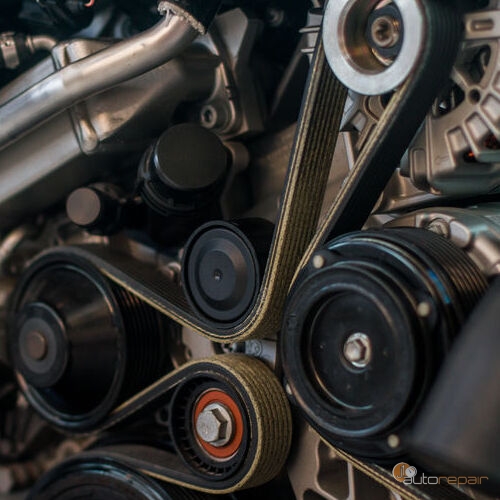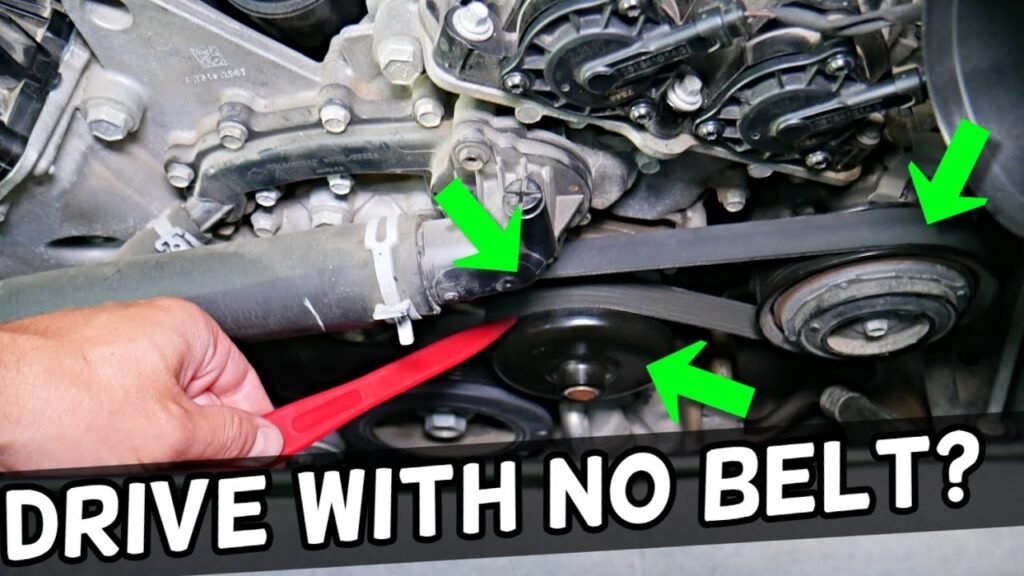No, you cannot drive a car without an alternator belt as it is responsible for powering essential components such as the power steering, AC, and water pump, among others. It is not recommended to drive without an alternator belt as it can lead to various issues and potential damage to the vehicle.
Understanding The Role Of The Alternator Belt
Driving a car without an alternator belt is not recommended as it can affect crucial components such as the power steering, AC, and water pump. It’s best to have the belt replaced to avoid potential problems while driving.
To understand the importance of the alternator belt in a car’s operation, it’s essential to grasp the function of the alternator itself. The alternator plays a crucial role in charging the battery and powering the electrical systems of a vehicle. Without a functioning alternator belt, the alternator cannot perform its duties effectively, which can lead to a host of problems. Let’s explore the significance of the alternator belt and its role in ensuring the smooth operation of your car.
Importance Of The Alternator Belt In A Car’s Operation
When considering the importance of the alternator belt, it’s important to highlight the essential tasks it facilitates. The alternator belt is responsible for driving the alternator, which is an integral component of the car’s electrical system. By connecting the engine with the alternator, the belt enables the alternator to receive the necessary mechanical power for its functioning.
The alternator, in turn, converts this mechanical power into electrical energy, which is used to charge the car’s battery and power the various electrical systems and components. These include essential features such as headlights, radio, power windows, air conditioning, and more. In short, the alternator belt ensures the continuous generation of electricity to meet the demands of your vehicle’s electrical systems.
Function Of The Alternator In Charging The Battery And Powering Electrical Systems
The primary function of the alternator is to keep the car’s battery charged while the engine is running. As the engine rotates, the alternator belt turns the alternator, causing it to produce alternating current (AC) electricity. The alternator then converts this AC electricity into direct current (DC) electricity, which is used to charge the battery.
Besides charging the battery, the alternator also provides electrical power to the car’s various electrical systems and components. This ensures that they operate efficiently and reliably. Without the alternator belt, the alternator cannot rotate and generate electricity, leading to a drained battery and a lack of electrical power for essential functions such as lights, air conditioning, and power steering.
Overall, the alternator belt is crucial for maintaining the proper operation of the alternator, which ultimately impacts the performance and reliability of your car. It is crucial to ensure the alternator belt is in good condition and free from damage or wear to avoid any potential issues that may arise from a faulty or broken belt.
Potential Consequences Of Driving Without An Alternator Belt
When it comes to driving a car without an alternator belt, several potential consequences can arise. Ignoring the issue and continuing to drive without the belt can lead to loss of power steering functionality, impact on the air conditioning system, affect the water pump and engine cooling, and extended driving without an alternator belt can potentially cause damage to the engine.
Loss Of Power Steering Functionality
One of the immediate impacts of driving without an alternator belt is the loss of power steering functionality. Without the belt powering the pump that assists with steering, the steering wheel can become extremely difficult to turn, making it challenging to maneuver the vehicle, especially at lower speeds or during tight turns.
Impact On The Air Conditioning System
In addition to power steering, the alternator belt also plays a role in powering the air conditioning system. Without the belt, the compressor that circulates refrigerant and cools the air will not function, resulting in a lack of cool air in the cabin. This can be particularly uncomfortable during hot weather or long drives.
Effect On The Water Pump And Engine Cooling
The alternator belt is responsible for driving the water pump, which plays a critical role in regulating engine temperature. Without the belt, the water pump will not be able to circulate coolant through the engine, leading to overheating. Extended driving under these conditions can cause severe engine damage and potentially even engine failure.
Extended Driving Without An Alternator Belt And Potential Damage To The Engine
Continuing to drive without an alternator belt for an extended period can have detrimental effects on the engine. Since the alternator belt is responsible for powering essential components like the water pump and air conditioning system, the lack of a functioning belt can put excessive strain on the engine, leading to decreased performance and potential damage. It is recommended to address the issue promptly to avoid costly repairs or even total engine failure.
Can You Drive A Short Distance Without An Alternator Belt?
Driving a car without an alternator belt is not recommended as it may affect the power steering, air conditioning, and water pump. It is best to have the belt replaced before driving to prevent potential damage to the vehicle.
Factors To Consider When Driving A Short Distance Without An Alternator Belt
Driving a short distance without an alternator belt can be a daunting situation. While it is possible to drive without this belt, there are some important factors to consider before attempting to do so:
Power Steering:
The alternator belt is responsible for powering the power steering pump. Without this belt, your steering may become heavy and difficult to control, especially at low speeds.
Air Conditioning:
The alternator belt also powers the air conditioning compressor. Without it, you may be left without a functioning air conditioning system, which can be uncomfortable, especially in hot weather.
Water Pump:
In some vehicles, the alternator belt also drives the water pump. This helps to circulate coolant and prevent the engine from overheating. Without the belt, there is a risk of engine overheating, which can lead to severe damage.
Battery Charging:
Since the alternator belt is responsible for powering the alternator, its absence means that the alternator will not be able to charge the battery. While you may be able to start the car initially, the battery’s charge will eventually run out, leading to a stalled vehicle.
Considering these factors, it is crucial to exercise caution and make informed decisions when driving a short distance without an alternator belt. Assess the importance of power steering, air conditioning, and a functioning water pump, as well as the condition of your battery, before proceeding.
Recommended Actions When Encountering A Broken Alternator Belt While Driving
If you find yourself in a situation where the alternator belt breaks while driving, it is important to take appropriate actions to ensure your safety and minimize damage to your vehicle. Here are some recommended steps to follow:
- Stay Calm: It is crucial to stay calm and keep a clear mind to safely handle the situation.
- Turn off Non-Essential Systems: To conserve battery power, turn off any non-essential systems such as the air conditioning and radio.
- Limit Driving Distance: If possible, try to limit your driving distance and aim to reach a safe location as soon as possible. This is to prevent further damage and avoid being stranded in an unsafe area.
- Watch for Warning Signs: Keep a close eye on the vehicle’s performance and watch for warning signs of overheating or loss of power steering. If any issues arise, pull over immediately and seek assistance.
- Call for Help: If the situation seems unsafe or your vehicle’s performance has been greatly affected, it is recommended to call for professional assistance or a tow truck.
- Get the Belt Replaced: Once you have reached a safe location, it is important to have the alternator belt replaced as soon as possible. This will ensure the proper functioning of essential systems and prevent future issues.
Remember, driving without an alternator belt should be considered a temporary solution and should only be done under exceptional circumstances. It is always best to consult a professional technician to assess the situation and provide the appropriate guidance.

Credit: www.j1autorepair.com
How Long Can You Drive Without An Alternator Belt?
Driving a car without an alternator belt is not recommended because it may also affect the power steering, AC, and water pump. While it is possible to drive a few miles without it, it is best to address the issue promptly to prevent further damage.
Factors Affecting How Long A Car Can Be Driven Without An Alternator Belt
Driving a car without an alternator belt can be a risky endeavor, as the alternator plays a critical role in powering various components of your vehicle. The duration for which you can drive without an alternator belt depends on several factors:
- Vehicle Battery Charge: If your vehicle’s battery is charged sufficiently when the alternator belt snaps, you may be able to drive for a short distance. The battery will provide power to essential systems, but its capacity will eventually deplete.
- Vehicle Electrical Demand: The electrical load generated by systems such as headlights, wipers, and radio can shorten the time you can drive without an alternator belt. Continuous use of these systems will drain the battery faster.
- Engine Temperature: Without the alternator belt, the water pump may not function correctly, leading to increased engine temperature. Elevated engine temperature can cause irreversible damage and overheating, limiting your driving time.
- Power Steering Availability: Some vehicles rely on the alternator belt to power the power steering pump. Without the belt, steering can become difficult, especially at low speeds, impacting your ability to control the vehicle safely.
Symptoms To Watch Out For When Driving Without An Alternator Belt
While driving without an alternator belt is discouraged, certain symptoms indicate the belt failure and can help you assess how long you can continue driving:
- Battery Warning Light: If the battery warning light on your dashboard illuminates, it indicates that the battery is not being charged and will eventually run out of power.
- Dimming Lights: As the battery loses its charge, you may notice your vehicle’s lights becoming increasingly dim. This indicates a decrease in available electrical power.
- Difficulty in Steering: Without the power assistance provided by the alternator belt, your steering may become heavier and more challenging to maneuver, making it unsafe to continue driving.
- Engine Overheating: If your engine temperature gauge starts rising rapidly, it is a warning sign that the water pump, driven by the alternator belt, is not functioning correctly. Pull over immediately to prevent severe engine damage.
Remember, driving without an alternator belt is a temporary solution and should only be done in emergencies. It is crucial to have your vehicle serviced as soon as possible to avoid additional damage and ensure the proper functioning of all systems.
Risks And Precautions Of Driving Without An Alternator Belt
Driving without an alternator belt can pose potential risks to both your vehicle and yourself as the driver. It is important to understand these risks and take necessary precautions if driving without an alternator belt becomes necessary.
Potential Risks To The Vehicle And Driver When Driving Without An Alternator Belt
Driving without an alternator belt can have several consequences, including:
- Loss of power steering: The alternator belt is responsible for powering the vehicle’s power steering system. Without it, steering the car can become extremely difficult, especially at low speeds.
- Malfunctioning of the air conditioning: In most vehicles, the air conditioning system is also driven by the alternator belt. Driving without the belt can lead to the failure of the air conditioning system, leaving you without cool air during hot weather.
- Overheating of the engine: The alternator belt drives the water pump, which is responsible for circulating coolant throughout the engine. Without proper coolant circulation, the engine can overheat, leading to potential engine damage.
- Loss of electrical power: The alternator belt drives the alternator, which charges the battery and provides electrical power to the vehicle. Driving without the belt will result in a drained battery and the loss of electrical power, including the headlights, radio, and other important functions.
Precautions To Take If Driving Without An Alternator Belt Is Necessary
If you find yourself in a situation where driving without an alternator belt is necessary, it is crucial to take certain precautions to minimize the risks involved:
- Drive safely and cautiously: Take extra care while driving without an alternator belt, especially when it comes to steering the vehicle. The absence of power steering can make it harder to control the car, particularly at low speeds.
- Monitor the temperature gauge: Keep a close eye on the engine temperature gauge to ensure it does not rise to dangerous levels. If you notice the temperature increasing rapidly, pull over and turn off the engine to prevent further damage.
- Limit your driving time: Driving without an alternator belt should only be done for short distances and as a temporary solution. The longer you drive without the belt, the higher the risk of damaging the engine or other components.
- Prepare for electrical failures: Since the alternator belt drives the alternator, you should expect a loss of electrical power during your drive. Make sure to fully charge your battery beforehand and avoid using any unnecessary electrical components while driving.
Remember, driving without an alternator belt should only be done as a last resort and for short distances. It is highly recommended to have the belt replaced as soon as possible to ensure the proper and safe functioning of your vehicle.
Frequently Asked Questions Of Can You Drive A Car Without An Alternator Belt
How Long Can A Car Run Without An Alternator Belt?
A car can run without an alternator belt, but it is not recommended. The alternator belt powers essential components such as the power steering, AC, and water pump. Driving without it may cause issues and potential damage.
What Happens To The Car If There Is No Alternator Belt?
Driving a car without an alternator belt is not recommended. The alternator belt is essential for powering important components such as the power steering, AC, and most importantly, the water pump. Without the alternator belt, you risk losing power and damaging the engine.
It is recommended to have the alternator belt replaced as soon as possible.
What Happens If Alternator Belt Breaks While Driving?
Driving with a broken alternator belt can lead to engine overheating, loss of power steering, and a drained battery. It is not recommended to drive without the alternator belt, as it can cause significant damage to the engine.
Conclusion
While it is technically possible to drive a car without an alternator belt, it is not recommended. The alternator belt is responsible for powering essential components like the power steering, AC, and most importantly, the water pump. Without the alternator belt, the battery will not charge, the engine may overheat, and the car’s performance will be compromised.
It is always advisable to have your alternator belt replaced promptly to avoid any potential damage or breakdown.

